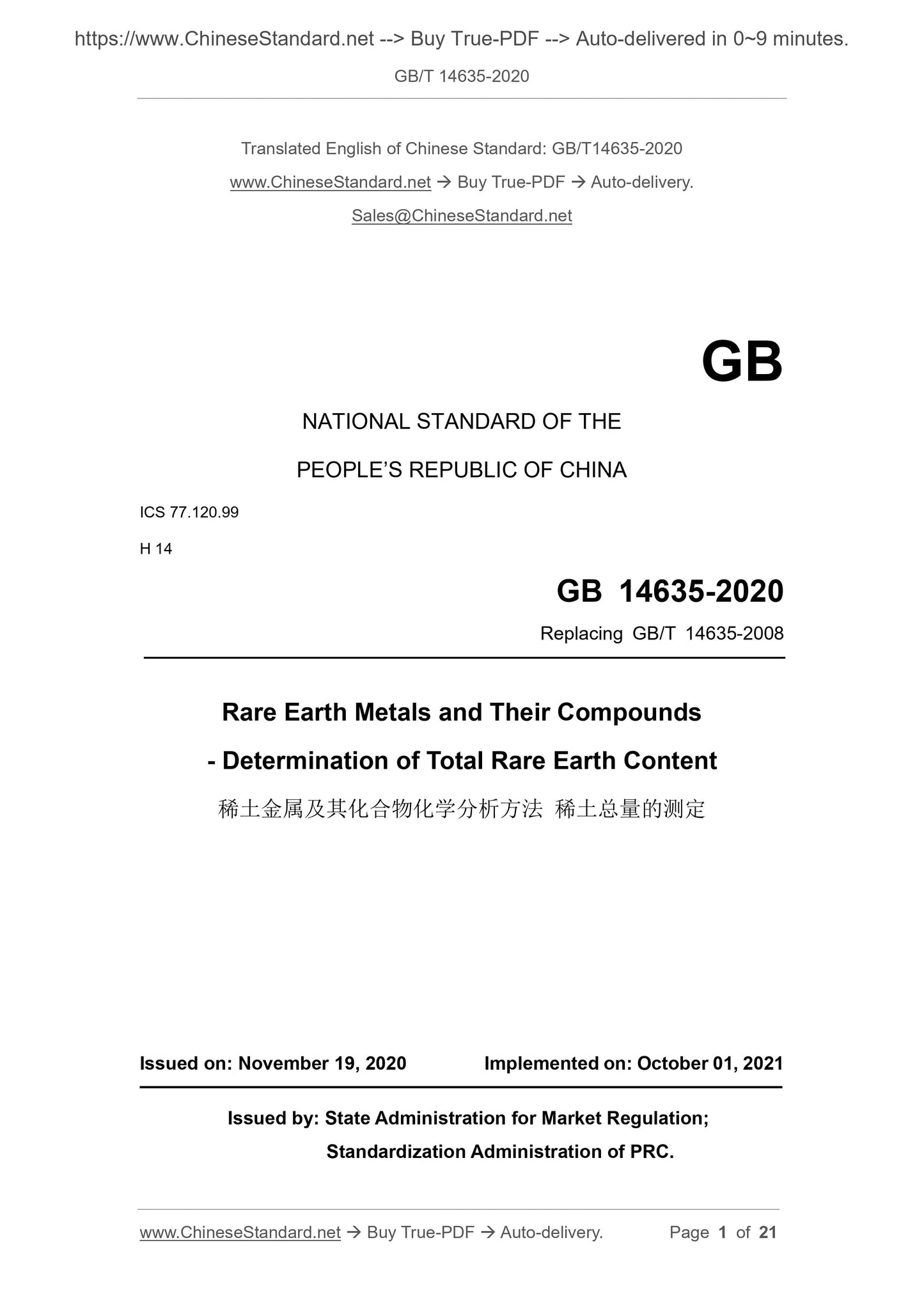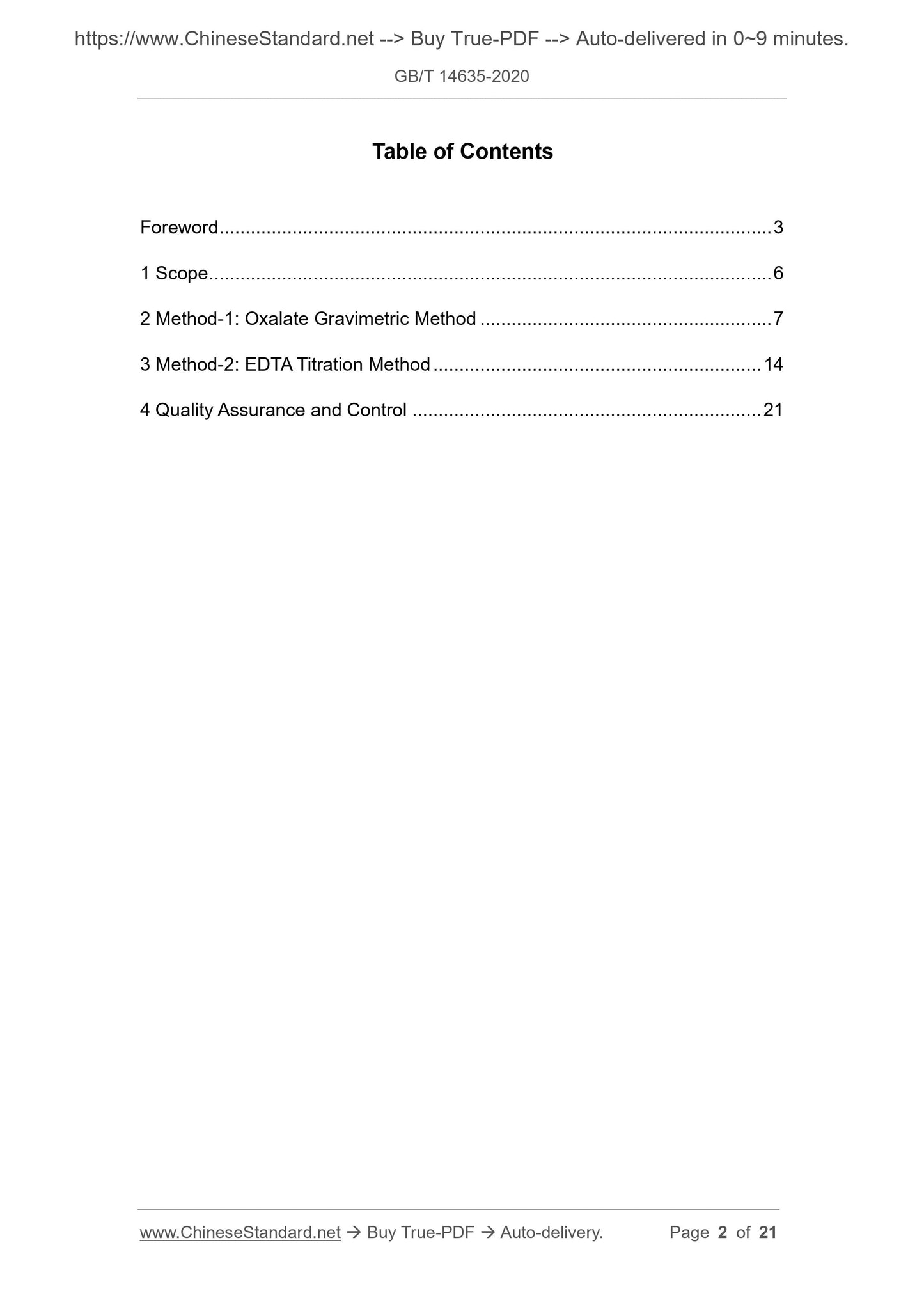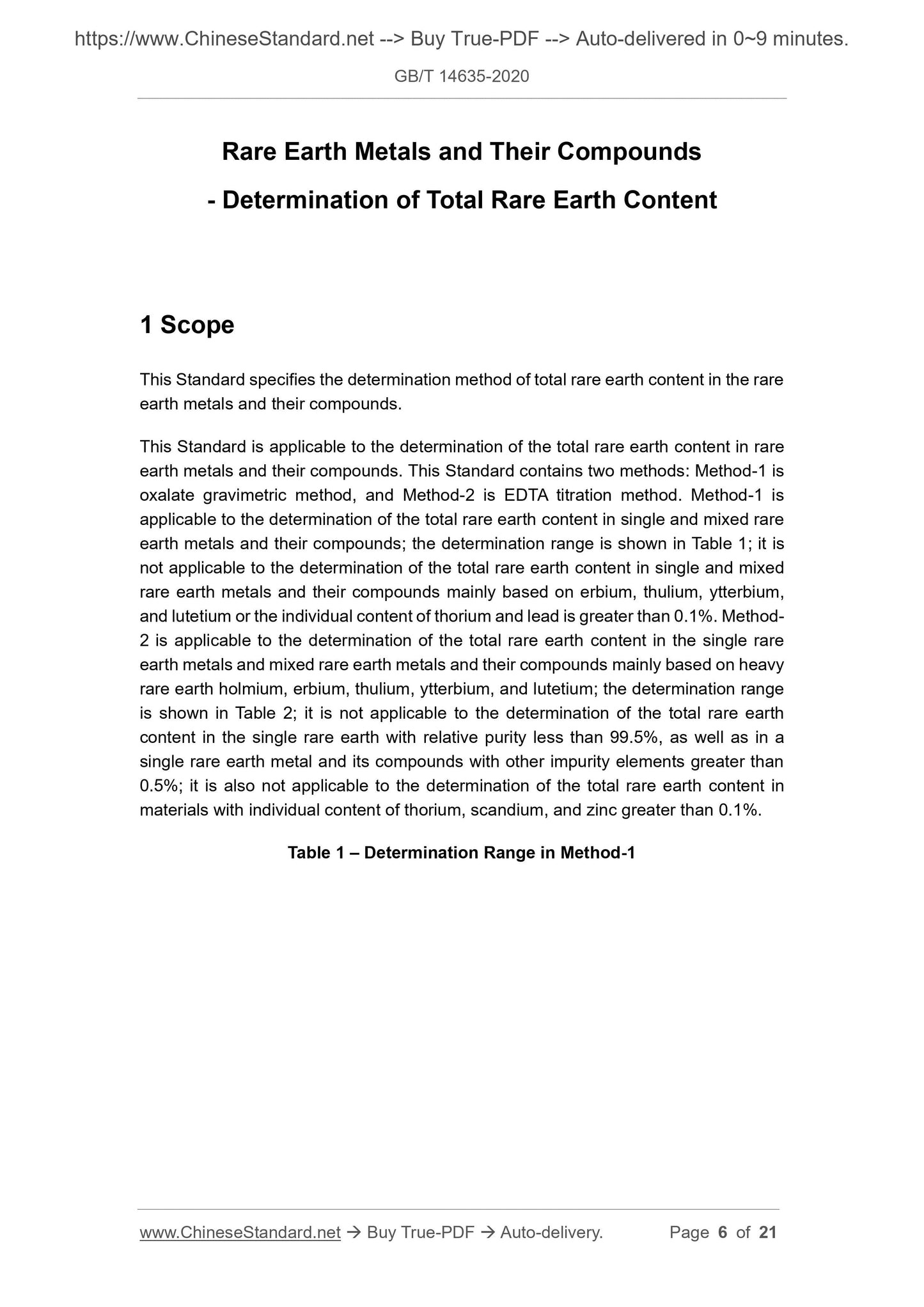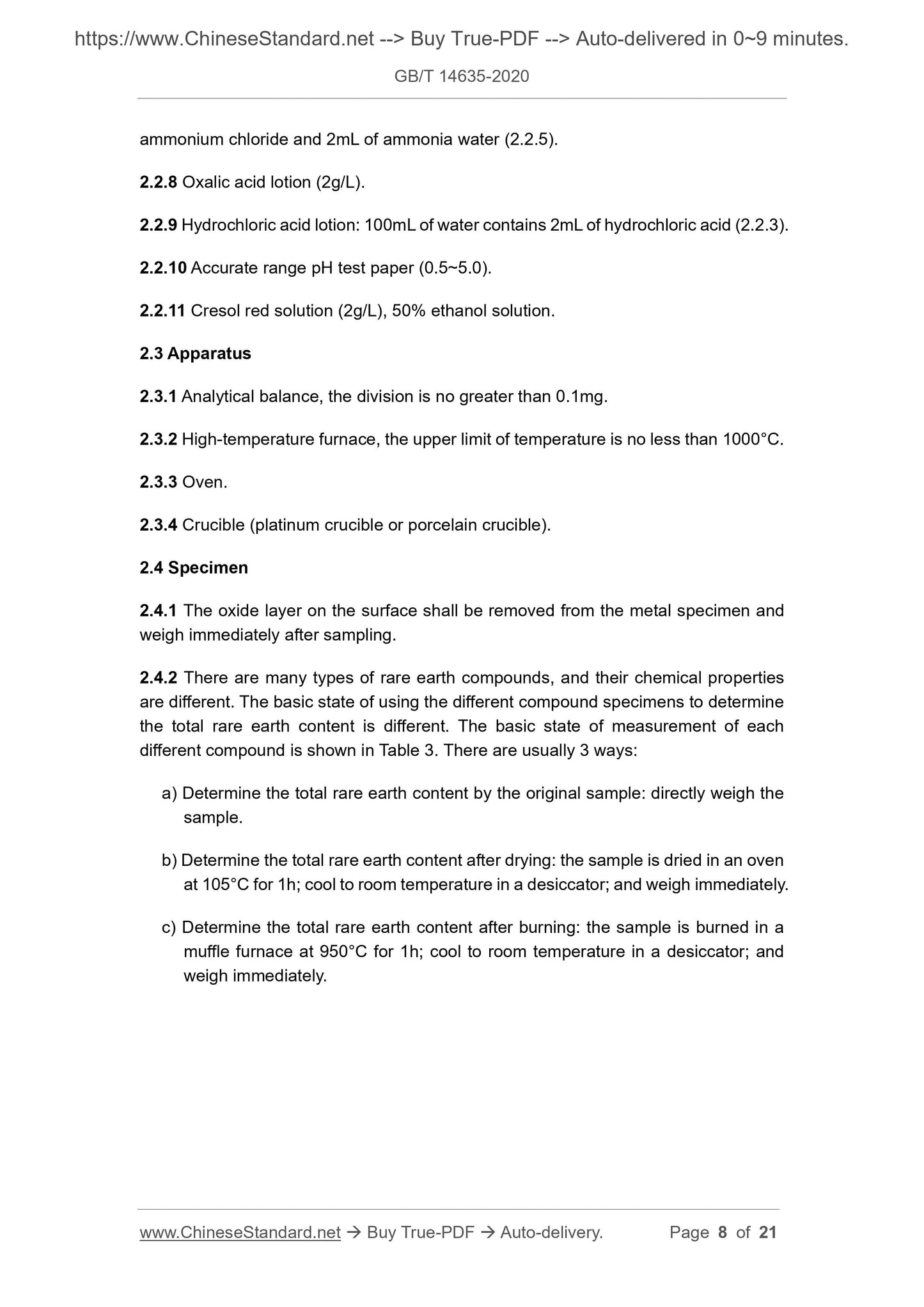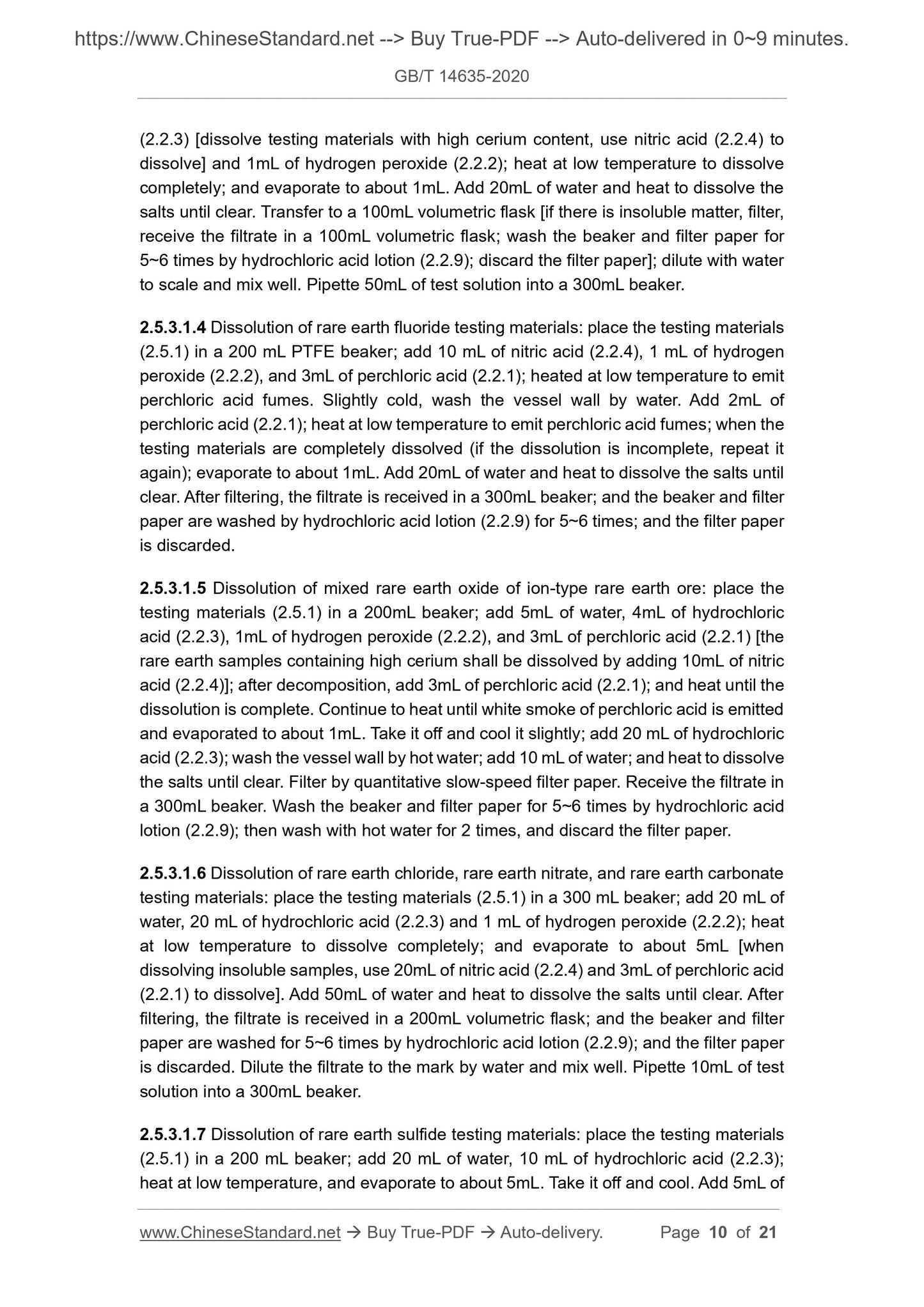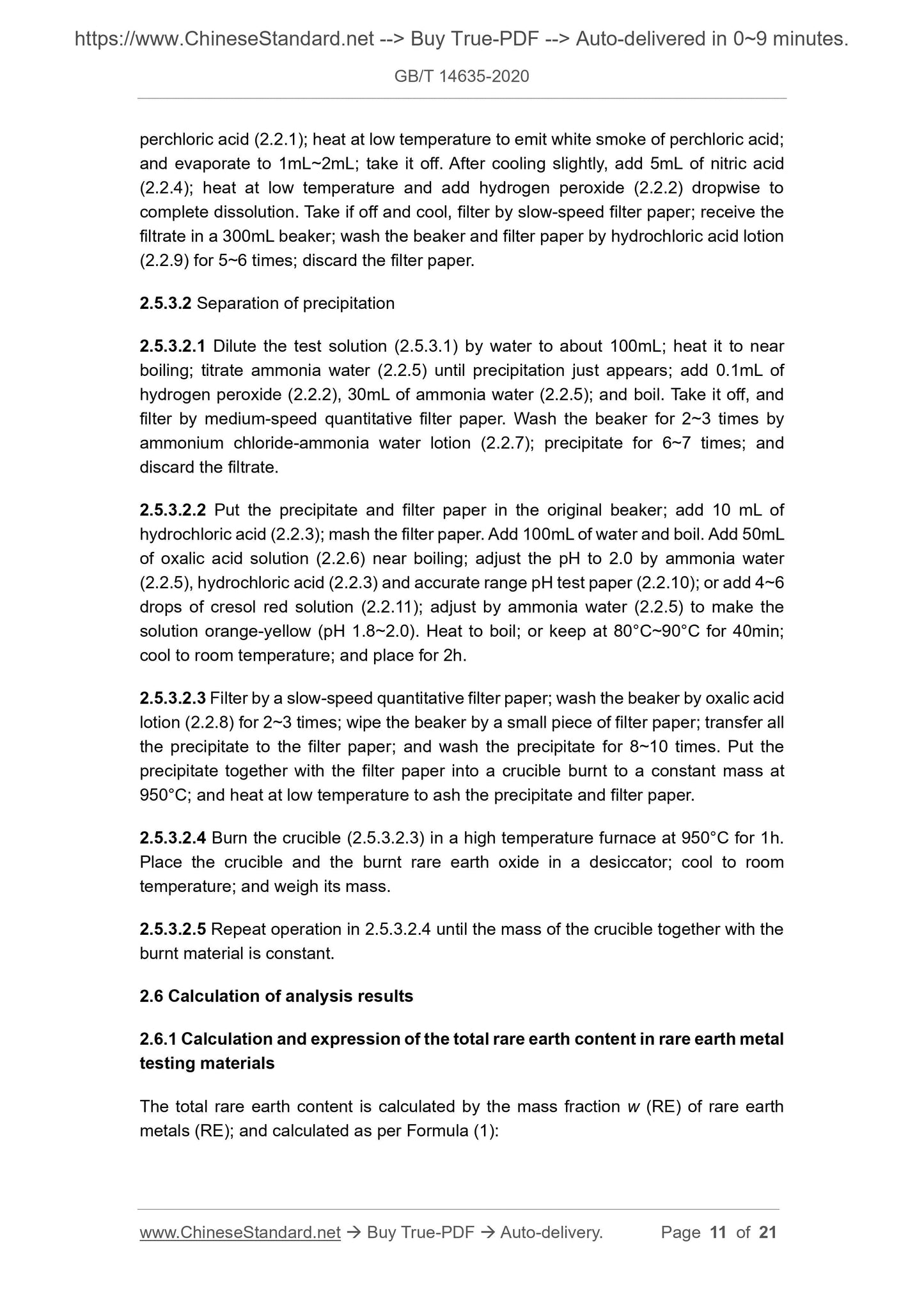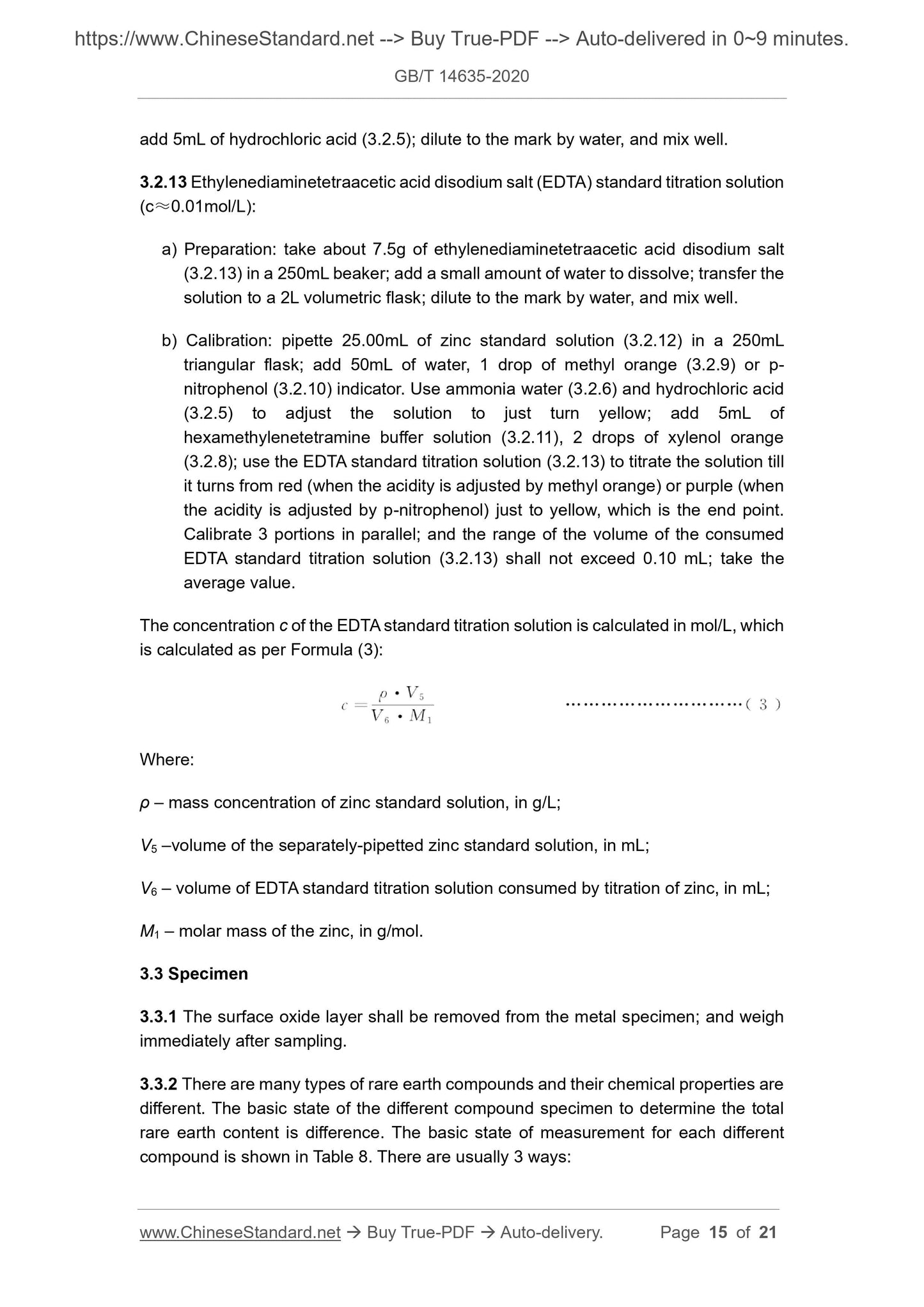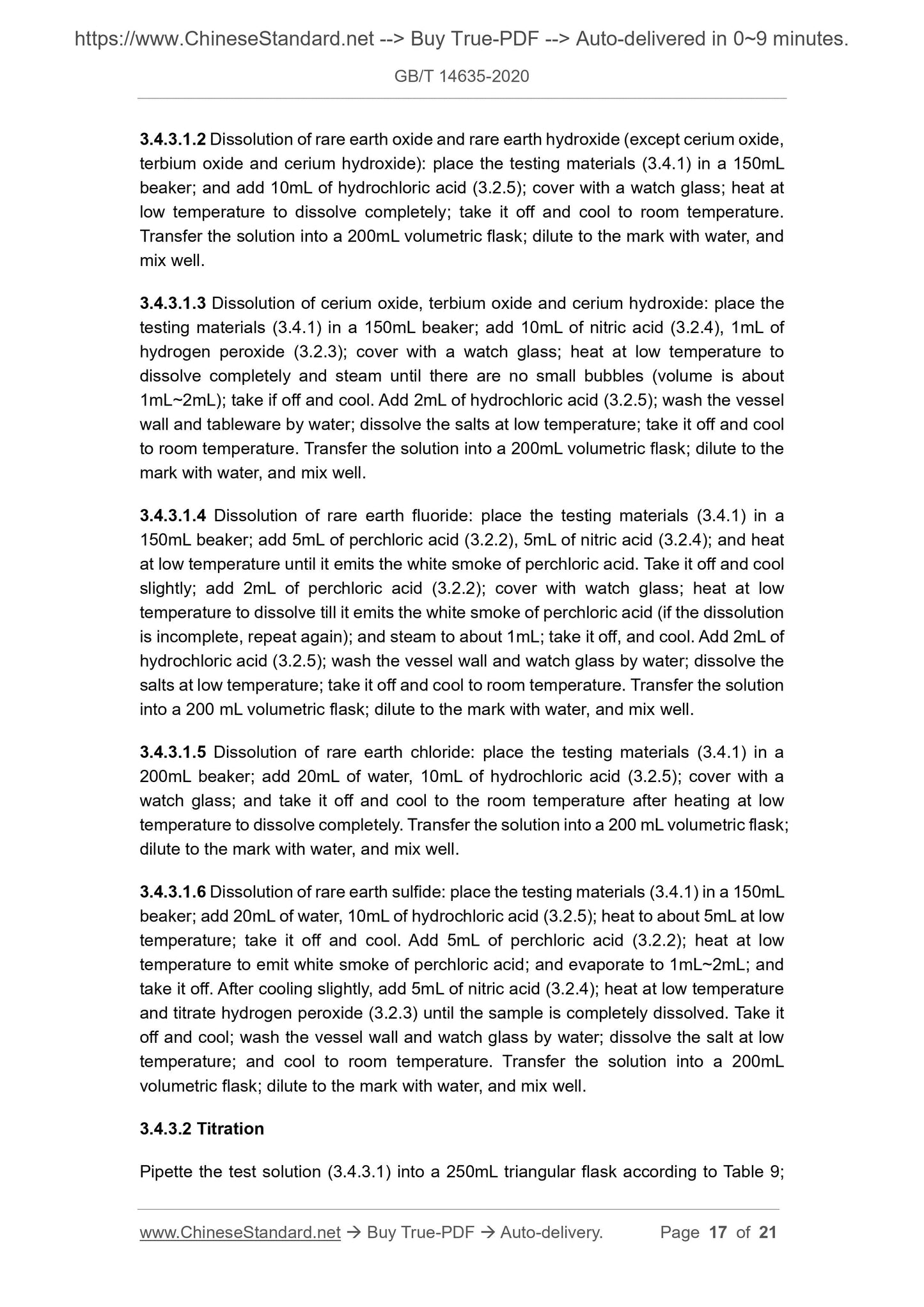1
/
de
8
PayPal, credit cards. Download editable-PDF and invoice in 1 second!
GB/T 14635-2020 English PDF (GBT14635-2020)
GB/T 14635-2020 English PDF (GBT14635-2020)
Prix habituel
$205.00 USD
Prix habituel
Prix promotionnel
$205.00 USD
Prix unitaire
/
par
Frais d'expédition calculés à l'étape de paiement.
Impossible de charger la disponibilité du service de retrait
Delivery: 3 seconds. Download true-PDF + Invoice.
Get QUOTATION in 1-minute: Click GB/T 14635-2020
Historical versions: GB/T 14635-2020
Preview True-PDF (Reload/Scroll if blank)
GB/T 14635-2020: Rare earth metals and their compounds -- Determination of total rare earth content
GB/T 14635-2020
GB
NATIONAL STANDARD OF THE
PEOPLE’S REPUBLIC OF CHINA
ICS 77.120.99
H 14
GB 14635-2020
Replacing GB/T 14635-2008
Rare Earth Metals and Their Compounds
- Determination of Total Rare Earth Content
ISSUED ON: NOVEMBER 19, 2020
IMPLEMENTED ON: OCTOBER 01, 2021
Issued by: State Administration for Market Regulation;
Standardization Administration of PRC.
Table of Contents
Foreword ... 3
1 Scope ... 6
2 Method-1: Oxalate Gravimetric Method ... 7
3 Method-2: EDTA Titration Method ... 14
4 Quality Assurance and Control ... 21
Rare Earth Metals and Their Compounds
- Determination of Total Rare Earth Content
1 Scope
This Standard specifies the determination method of total rare earth content in the rare
earth metals and their compounds.
This Standard is applicable to the determination of the total rare earth content in rare
earth metals and their compounds. This Standard contains two methods: Method-1 is
oxalate gravimetric method, and Method-2 is EDTA titration method. Method-1 is
applicable to the determination of the total rare earth content in single and mixed rare
earth metals and their compounds; the determination range is shown in Table 1; it is
not applicable to the determination of the total rare earth content in single and mixed
rare earth metals and their compounds mainly based on erbium, thulium, ytterbium,
and lutetium or the individual content of thorium and lead is greater than 0.1%. Method-
2 is applicable to the determination of the total rare earth content in the single rare
earth metals and mixed rare earth metals and their compounds mainly based on heavy
rare earth holmium, erbium, thulium, ytterbium, and lutetium; the determination range
is shown in Table 2; it is not applicable to the determination of the total rare earth
content in the single rare earth with relative purity less than 99.5%, as well as in a
single rare earth metal and its compounds with other impurity elements greater than
0.5%; it is also not applicable to the determination of the total rare earth content in
materials with individual content of thorium, scandium, and zinc greater than 0.1%.
Table 1 – Determination Range in Method-1
ammonium chloride and 2mL of ammonia water (2.2.5).
2.2.8 Oxalic acid lotion (2g/L).
2.2.9 Hydrochloric acid lotion: 100mL of water contains 2mL of hydrochloric acid (2.2.3).
2.2.10 Accurate range pH test paper (0.5~5.0).
2.2.11 Cresol red solution (2g/L), 50% ethanol solution.
2.3 Apparatus
2.3.1 Analytical balance, the division is no greater than 0.1mg.
2.3.2 High-temperature furnace, the upper limit of temperature is no less than 1000°C.
2.3.3 Oven.
2.3.4 Crucible (platinum crucible or porcelain crucible).
2.4 Specimen
2.4.1 The oxide layer on the surface shall be removed from the metal specimen and
weigh immediately after sampling.
2.4.2 There are many types of rare earth compounds, and their chemical properties
are different. The basic state of using the different compound specimens to determine
the total rare earth content is different. The basic state of measurement of each
different compound is shown in Table 3. There are usually 3 ways:
a) Determine the total rare earth content by the original sample: directly weigh the
sample.
b) Determine the total rare earth content after drying: the sample is dried in an oven
at 105°C for 1h; cool to room temperature in a desiccator; and weigh immediately.
c) Determine the total rare earth content after burning: the sample is burned in a
muffle furnace at 950°C for 1h; cool to room temperature in a desiccator; and
weigh immediately.
(2.2.3) [dissolve testing materials with high cerium content, use nitric acid (2.2.4) to
dissolve] and 1mL of hydrogen peroxide (2.2.2); heat at low temperature to dissolve
completely; and evaporate to about 1mL. Add 20mL of water and heat to dissolve the
salts until clear. Transfer to a 100mL volumetric flask [if there is insoluble matter, filter,
receive the filtrate in a 100mL volumetric flask; wash the beaker and filter paper for
5~6 times by hydrochloric acid lotion (2.2.9); discard the filter paper]; dilute with water
to scale and mix well. Pipette 50mL of test solution into a 300mL beaker.
2.5.3.1.4 Dissolution of rare earth fluoride testing materials: place the testing materials
(2.5.1) in a 200 mL PTFE beaker; add 10 mL of nitric acid (2.2.4), 1 mL of hydrogen
peroxide (2.2.2), and 3mL of perchloric acid (2.2.1); heated at low temperature to emit
perchloric acid fumes. Slightly cold, wash the vessel wall by water. Add 2mL of
perchloric acid (2.2.1); heat at low temperature to emit perchloric acid fumes; when the
testing materials are completely dissolved (if the dissolution is incomplete, repeat it
again); evaporate to about 1mL. Add 20mL of water and heat to dissolve the salts until
clear. After filtering, the filtrate is received in a 300mL beaker; and the beaker and filter
paper are washed by hydrochloric acid lotion (2.2.9) for 5~6 times; and the filter paper
is discarded.
2.5.3.1.5 Dissolution of mixed rare earth oxide of ion-type rare earth ore: place the
testing materials (2.5.1) in a 200mL beaker; add 5mL of water, 4mL of hydrochloric
acid (2.2.3), 1mL of hydrogen peroxide (2.2.2), and 3mL of perchloric acid (2.2.1) [the
rare earth samples containing high cerium shall be dissolved by adding 10mL of nitric
acid (2.2.4)]; after decomposition, add 3mL of perchloric acid (2.2.1); and heat until the
dissolution is complete. Continue to heat until white smoke of perchloric acid is emitted
and evaporated to about 1mL. Take it off and cool it slightly; add 20 mL of hydrochloric
acid (2.2.3); wash the vessel wall by hot water; add 10 mL of water; and heat to dissolve
the salts until clear. Filter by quantitative slow-speed filter paper. Receive the filtrate in
a 300mL beaker. Wash the beaker and filter paper for 5~6 times by hydrochloric acid
lotion (2.2.9); then wash with hot water for 2 times, and discard the filter paper.
2.5.3.1.6 Dissolution of rare earth chloride, rare earth nitrate, and rare earth carbonate
testing materials: place the testing materials (2.5.1) in a 300 mL beaker; add 20 mL of
water, 20 mL of hydrochloric acid (2.2.3) and 1 mL of hydrogen peroxide (2.2.2); heat
at low temperature to dissolve completely; and evaporate to about 5mL [when
dissolving insoluble samples, use 20mL of nitric acid (2.2.4) and 3mL of perchloric acid
(2.2.1) to dissolve]. Add 50mL of water and heat to dissolve the salts until clear. After
filtering, the filtrate is received in a 200mL volumetric flask; and the beaker and filter
paper are washed for 5~6 times by hydrochloric acid lotion (2.2.9); and the filter paper
is discarded. Dilute the filtrate to the mark by water and mix well. Pipette 10mL of test
solution into a 300mL beaker.
2.5.3.1.7 Dissolution of rare earth sulfide testing materials: place the testing materials
(2.5.1) in a 200 mL beaker; add 20 mL of water, 10 mL of hydrochloric acid (2.2.3);
heat at low temperature, and evaporate to about 5mL. Take it off and cool. Add 5mL of
perchloric acid (2.2.1); heat at low temperature to emit white smoke of perchloric acid;
and evaporate to 1mL~2mL; take it off. After cooling slightly, add 5mL of nitric acid
(2.2.4); heat at low temperature and add hydrogen peroxide (2.2.2) dropwise to
complete dissolution. Take if off and cool, filter by slow-speed filter paper; receive the
filtrate in a 300mL beaker; wash the beaker and filter paper by hydrochloric ...
Get QUOTATION in 1-minute: Click GB/T 14635-2020
Historical versions: GB/T 14635-2020
Preview True-PDF (Reload/Scroll if blank)
GB/T 14635-2020: Rare earth metals and their compounds -- Determination of total rare earth content
GB/T 14635-2020
GB
NATIONAL STANDARD OF THE
PEOPLE’S REPUBLIC OF CHINA
ICS 77.120.99
H 14
GB 14635-2020
Replacing GB/T 14635-2008
Rare Earth Metals and Their Compounds
- Determination of Total Rare Earth Content
ISSUED ON: NOVEMBER 19, 2020
IMPLEMENTED ON: OCTOBER 01, 2021
Issued by: State Administration for Market Regulation;
Standardization Administration of PRC.
Table of Contents
Foreword ... 3
1 Scope ... 6
2 Method-1: Oxalate Gravimetric Method ... 7
3 Method-2: EDTA Titration Method ... 14
4 Quality Assurance and Control ... 21
Rare Earth Metals and Their Compounds
- Determination of Total Rare Earth Content
1 Scope
This Standard specifies the determination method of total rare earth content in the rare
earth metals and their compounds.
This Standard is applicable to the determination of the total rare earth content in rare
earth metals and their compounds. This Standard contains two methods: Method-1 is
oxalate gravimetric method, and Method-2 is EDTA titration method. Method-1 is
applicable to the determination of the total rare earth content in single and mixed rare
earth metals and their compounds; the determination range is shown in Table 1; it is
not applicable to the determination of the total rare earth content in single and mixed
rare earth metals and their compounds mainly based on erbium, thulium, ytterbium,
and lutetium or the individual content of thorium and lead is greater than 0.1%. Method-
2 is applicable to the determination of the total rare earth content in the single rare
earth metals and mixed rare earth metals and their compounds mainly based on heavy
rare earth holmium, erbium, thulium, ytterbium, and lutetium; the determination range
is shown in Table 2; it is not applicable to the determination of the total rare earth
content in the single rare earth with relative purity less than 99.5%, as well as in a
single rare earth metal and its compounds with other impurity elements greater than
0.5%; it is also not applicable to the determination of the total rare earth content in
materials with individual content of thorium, scandium, and zinc greater than 0.1%.
Table 1 – Determination Range in Method-1
ammonium chloride and 2mL of ammonia water (2.2.5).
2.2.8 Oxalic acid lotion (2g/L).
2.2.9 Hydrochloric acid lotion: 100mL of water contains 2mL of hydrochloric acid (2.2.3).
2.2.10 Accurate range pH test paper (0.5~5.0).
2.2.11 Cresol red solution (2g/L), 50% ethanol solution.
2.3 Apparatus
2.3.1 Analytical balance, the division is no greater than 0.1mg.
2.3.2 High-temperature furnace, the upper limit of temperature is no less than 1000°C.
2.3.3 Oven.
2.3.4 Crucible (platinum crucible or porcelain crucible).
2.4 Specimen
2.4.1 The oxide layer on the surface shall be removed from the metal specimen and
weigh immediately after sampling.
2.4.2 There are many types of rare earth compounds, and their chemical properties
are different. The basic state of using the different compound specimens to determine
the total rare earth content is different. The basic state of measurement of each
different compound is shown in Table 3. There are usually 3 ways:
a) Determine the total rare earth content by the original sample: directly weigh the
sample.
b) Determine the total rare earth content after drying: the sample is dried in an oven
at 105°C for 1h; cool to room temperature in a desiccator; and weigh immediately.
c) Determine the total rare earth content after burning: the sample is burned in a
muffle furnace at 950°C for 1h; cool to room temperature in a desiccator; and
weigh immediately.
(2.2.3) [dissolve testing materials with high cerium content, use nitric acid (2.2.4) to
dissolve] and 1mL of hydrogen peroxide (2.2.2); heat at low temperature to dissolve
completely; and evaporate to about 1mL. Add 20mL of water and heat to dissolve the
salts until clear. Transfer to a 100mL volumetric flask [if there is insoluble matter, filter,
receive the filtrate in a 100mL volumetric flask; wash the beaker and filter paper for
5~6 times by hydrochloric acid lotion (2.2.9); discard the filter paper]; dilute with water
to scale and mix well. Pipette 50mL of test solution into a 300mL beaker.
2.5.3.1.4 Dissolution of rare earth fluoride testing materials: place the testing materials
(2.5.1) in a 200 mL PTFE beaker; add 10 mL of nitric acid (2.2.4), 1 mL of hydrogen
peroxide (2.2.2), and 3mL of perchloric acid (2.2.1); heated at low temperature to emit
perchloric acid fumes. Slightly cold, wash the vessel wall by water. Add 2mL of
perchloric acid (2.2.1); heat at low temperature to emit perchloric acid fumes; when the
testing materials are completely dissolved (if the dissolution is incomplete, repeat it
again); evaporate to about 1mL. Add 20mL of water and heat to dissolve the salts until
clear. After filtering, the filtrate is received in a 300mL beaker; and the beaker and filter
paper are washed by hydrochloric acid lotion (2.2.9) for 5~6 times; and the filter paper
is discarded.
2.5.3.1.5 Dissolution of mixed rare earth oxide of ion-type rare earth ore: place the
testing materials (2.5.1) in a 200mL beaker; add 5mL of water, 4mL of hydrochloric
acid (2.2.3), 1mL of hydrogen peroxide (2.2.2), and 3mL of perchloric acid (2.2.1) [the
rare earth samples containing high cerium shall be dissolved by adding 10mL of nitric
acid (2.2.4)]; after decomposition, add 3mL of perchloric acid (2.2.1); and heat until the
dissolution is complete. Continue to heat until white smoke of perchloric acid is emitted
and evaporated to about 1mL. Take it off and cool it slightly; add 20 mL of hydrochloric
acid (2.2.3); wash the vessel wall by hot water; add 10 mL of water; and heat to dissolve
the salts until clear. Filter by quantitative slow-speed filter paper. Receive the filtrate in
a 300mL beaker. Wash the beaker and filter paper for 5~6 times by hydrochloric acid
lotion (2.2.9); then wash with hot water for 2 times, and discard the filter paper.
2.5.3.1.6 Dissolution of rare earth chloride, rare earth nitrate, and rare earth carbonate
testing materials: place the testing materials (2.5.1) in a 300 mL beaker; add 20 mL of
water, 20 mL of hydrochloric acid (2.2.3) and 1 mL of hydrogen peroxide (2.2.2); heat
at low temperature to dissolve completely; and evaporate to about 5mL [when
dissolving insoluble samples, use 20mL of nitric acid (2.2.4) and 3mL of perchloric acid
(2.2.1) to dissolve]. Add 50mL of water and heat to dissolve the salts until clear. After
filtering, the filtrate is received in a 200mL volumetric flask; and the beaker and filter
paper are washed for 5~6 times by hydrochloric acid lotion (2.2.9); and the filter paper
is discarded. Dilute the filtrate to the mark by water and mix well. Pipette 10mL of test
solution into a 300mL beaker.
2.5.3.1.7 Dissolution of rare earth sulfide testing materials: place the testing materials
(2.5.1) in a 200 mL beaker; add 20 mL of water, 10 mL of hydrochloric acid (2.2.3);
heat at low temperature, and evaporate to about 5mL. Take it off and cool. Add 5mL of
perchloric acid (2.2.1); heat at low temperature to emit white smoke of perchloric acid;
and evaporate to 1mL~2mL; take it off. After cooling slightly, add 5mL of nitric acid
(2.2.4); heat at low temperature and add hydrogen peroxide (2.2.2) dropwise to
complete dissolution. Take if off and cool, filter by slow-speed filter paper; receive the
filtrate in a 300mL beaker; wash the beaker and filter paper by hydrochloric ...
Share
